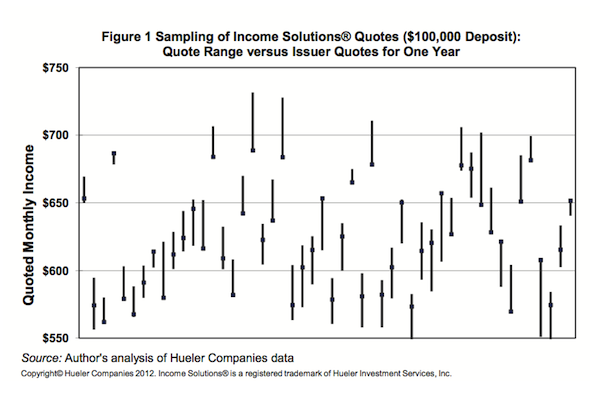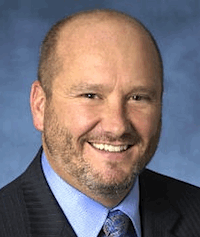In the wake of losses, Genworth CEO resigns
Genworth Financial chairman and CEO Michael D. Fraizer resigned on May 1, and the board has named chief financial officer Martin P. Klein as interim CEO while it searches for a successor, the company reported.
Fraizer led the insurer through its initial public offering by GE in 2004 and the recent financial and housing crisis. In a statement, he said this is “the right time for me to move on to other opportunities.”
The board named James S. Riepe, a company director since 2006, non-executive chairman. Klein will remain CFO while acting as CEO.
In addition to the top management changes, Genworth reported that its profit and revenue declined in the first quarter. Net income fell to $47 million, or 9 cents a share, for the three months ended March 31. That compares with $59 million, or 12 cents a share, in the same period last year.
The latest quarter included a loss of $41 million related to a transaction by its U.S. life insurance segment. Operating income, which excludes investment gains and losses, slipped to $31 million, or 6 cents per share, from $75 million, or 15 cents per share, last year.
Revenue slipped to $2.43 billion from $2.57 billion a year earlier, reflecting lower premiums. Results missed Street expectations. On average, analysts surveyed by FactSet forecast quarterly operating income of 13 cents per share and revenue of $2.6 billion.
Genworth’s Joelson to succeed Doll as CIO of Northwestern Mutual
Ron Joelson, current chief investment officer of Genworth Financial, will join Northwestern Mutual on June 4, succeeding Mark Doll as the company’s chief investment officer. Doll will retire on June 30 after 40 years with Northwestern Mutual.
Joelson, who currently manages Genworth’s $75 billion investment portfolio, spent most of his career at Prudential Financial, where his last position was senior vice president and chief investment officer–asset liability and risk management. He oversaw investment strategy and portfolio performance for Prudential’s $230 billion general account.
Joelson earned a BA from Hamilton College and an MBA from Columbia.
Doll, Northwestern Mutual’s chief investment officer since June 2008, oversaw a $164 billion general account investment portfolio.
Jackson launches MarketGuard Stretch for VA beneficiaries
Jackson National Life has introduced MarketGuard Stretch, a new variable annuity guaranteed minimum withdrawal benefit rider that “allows beneficiaries the flexibility to spread distribution payments over their lifetime, keeping more money in a tax-deferred account for continued growth potential.”
According to a Jackson release, policyholders can use MarketGuard Stretch to avoid a lump sum death benefit in favor of longer-term distributions, to provide for potentially young and inexperienced beneficiaries. The beneficiary’s required minimum distributions (RMD) will be determined annually based on the current account value and life expectancy.
“MarketGuard Stretch is the first stretch-friendly GMWB in the industry, allowing us to enhance the value proposition of variable annuities and expand Jackson’s relevance to a wider market,” said Clifford Jack, head of retail for Jackson.
MarketGuard Stretch is intended to give contract owners more control over beneficiaries’ distributions, allowing wealth to be spread to future generations. The withdrawal benefit can also help guarantee return of premium on a stretch contract over a number of years, regardless of investment performance.
Policyholders can take up to 5.5% of their protected balance each year, or their stretch RMD, if higher, depending on their age at the time of the first withdrawal. The options allow for distribution of the original investment amount without risking an excess withdrawal.
In some circumstances, remainder beneficiaries may also elect to continue the MarketGuard Stretch benefit, guaranteeing they will receive at least the remaining protected balance back while remaining in a tax-deferred contract.
“The new policy gives us the opportunity to provide beneficiaries – who may be unfamiliar with the complexities of investing – with an approach to planning that can help ensure their long-term financial health,” said Alison Reed, senior vice president of Product and Investment Management at Jackson National.
In March 2011, Jackson introduced the Portfolio Construction Tool, an interactive online solution that helps advisers build customized investment portfolios inside Jackson variable annuities. In October 2010, Jackson introduced LifeGuard Freedom Flex, billed as the industry’s first customizable GMWB.
The Hartford to sell individual annuity new business capabilities to Forethought
Forethought, a Houston-based privately held diversified financials services company, has agreed to buy The Hartford’s Individual Annuity new business capabilities, consisting of the product management, distribution and marketing units, as well as the suite of products currently being sold.
The terms of the agreement were not disclosed, but are not considered material to The Hartford’s operations or financial results. The majority of the current employees that support The Hartford’s Individual Annuity new business capabilities will be offered positions with Forethought.
The Hartford will continue to write new annuity products during a transition period and Forethought will assume all expenses and risk for these sales through a reinsurance arrangement. The agreement does not include The Hartford’s in-force annuity book of business.
Nationstar Mortgage to buy MetLife Bank’s ‘Reverse Servicing Portfolio’
MetLife, Inc. is exiting the reverse mortgage business, and Nationstar Mortgage LLC will buy MetLife Bank’s reverse mortgage servicing portfolio, pending regulatory approvals and closing conditions. MetLife Bank will not accept new reverse mortgage loan applications and registrations.
MetLife’s retail banking business, including mortgages, represented less than 2% of MetLife’s 2011 operating earnings. But because MetLife owns a bank, it was considered a bank holding company and therefore underwent the Federal Reserve’s Comprehensive Capital Analysis and Review Test (“stress test”) in March and—despite MetLife’s financial strength as an insurer—failed it.
After the test, MetLife’s CEO clarified the situation. “The bank-centric methodologies used under the CCAR are not appropriate for insurance companies, which operate under a different business model than banks,” said Steven A. Kardarian. “The established ratios used to measure insurance company capital adequacy, such as the NAIC’s risk-based capital ratio, show that MetLife is financially strong. At year-end 2011, MetLife had a consolidated risk-based capital ratio of 450%, well in excess of regulatory minimums.”
In 2011, MetLife had already decided to sell its bank and relinquish its bank holding company structure. It has reached agreements to sell MetLife Bank’s deposit business to GE Capital and to sell the bank’s warehouse finance business to EverBank. In addition, the bank has ceased taking forward mortgage applications.
MetLife was advised by K&L Gates LLP and Deutsche Bank Securities Inc.
Hammond to succeed Bibliowicz in top job at NFP
National Financial Partners Corp., a provider of benefits, insurance and wealth management services, said it has begun to implement a management succession plan.
Jessica M. Bibliowicz, chairman and chief executive officer, will voluntarily step down as president immediately, to be succeeded by Douglas W. Hammond, the current chief operating officer.
Bibliowicz will step down as CEO on March 31, 2013, when Hammond will succeed her and she will become the non-executive chairman at such time. Bibliowicz has been NFP’s president and CEO since April 1999. She served as a director since June 1999 and as chairman since June 2003.
Mr. Hammond, 46, has served as COO of NFP since 2008. He was NFP’s EVP and general counsel from 2004 to 2008. Before joining NFP in 1999, he was an attorney with the law firm currently known as Dewey & LeBoeuf LLP. He received his B.A. from Fairfield University and J.D. from St. John’s University School of Law.
Pension liabilities in UK dwarf GDP, in a sense
The United Kingdom’s total pension liabilities exceed £7trn (€8.1trn, $10.7trn) and are nearly five times Britain’s GDP, according to the Office of National Statistics (ONS), IPE.com reported.
State pension obligations make up more than three-quarters of total government liabilities, with both funded and unfunded obligations incurred through public pension plans accounting for the remaining £1.2trn of the £5trn in liabilities.
The £900bn in unfunded pension obligations amounted to 58% of GDP, while outstanding state pension payments were 269% of GDP, the report said.
Examining private sector obligations, ONS pensions analyst Sarah Levy said £1.3trn in obligations stemmed from defined benefit schemes, while a further £386bn of assets were located in defined contribution funds.
Mel Duffield, head of research at the National Association of Pension Funds, added: “These are big figures, but it must be remembered that public sector pensions cover millions of past and current workers and, in the case of the state pension, most of the UK population.”
The ONS stressed that all calculations covering obligations until 2010 were produced on a voluntary basis and should be viewed as “experimental statistics,” with refinements expected in future publications. The undertaking comes as European Union member states seek to comply with the European System of National and Regional Accounts proposed several years ago.
Levy, the author of the research, said she did not include any future obligations in her calculations. “As the European Central Bank has pointed out, in order to assess the fiscal sustainability of unfunded pension schemes, ‘the concept of pension entitlements needs to be extended to include entitlements that will be accrued in future, while at the same time comparing these ‘claims’ with future social contributions and tax payments’,” she wrote.
However, Levy stressed that all figures presented did not serve as an indicator of how financially sustainable the country’s pension system was at present.
Many financially unprepared for long lives: Northwestern Mutual
Americans appear to be “startlingly unprepared financially” to live past age 70, according to a new Longevity & Preparedness Study from Northwestern Mutual Life. The study is the company’s second in a series.
Only 56% of Americans surveyed (56%) feel financially prepared to live to the age of 75, while only 46% felt prepared to live to 85 and just 36% felt prepared to live to 95. According to the Centers for Disease Control, among couples who are age 65 today, there’s a 50% likelihood that one partner will live to age 94 and a 10% chance that one partner will live to age 100.
The research indicates:
- Regardless of age, men are more likely than women to feel financially prepared to live to age 75 (65% vs. 48%), 85 (55% vs. 37%), and 95 (43% vs. 30%).
- Younger Americans (25-59) feel less prepared than older Americans (60+) to live to 75 (47% vs. 79%), 85 (37% vs. 66%), and 95 (29% vs. 52%)
The first study in this series of research, called the Planning and Progress Study, showed that 21% of Americans would like to be more cautious with their money but feel they have a lot of catching up to do.
Independent research firm Ipsos conducted the online survey of 1,015 Americans aged 25 or older between February 2 and February 13, 2012. Results were weighted as needed to U.S. Census proportions for age, gender, marital status, household size, region and household income.
GDP growth slows, with consumer spending up and defense spending down
U.S. Gross Domestic Product grew just 2.2% in Q1 2012 (Qtr over Qtr, annualized), below expectations of 2.7% and well under the 3% growth rate in Q4 2011. On an annual basis, GDP rose 2.1% (year over year) after 1.6% growth in Q4, according to Prudential International Investments Advisors.
Within GDP, consumer spending rose 2.9%, while business investment spending fell 2.1% and government spending declined 3%. Consumer spending added 2% to Q1 GDP growth while government spending subtracted 0.6% and business investment subtracted 0.2% from Q1 growth.
Weaker inventory accumulation was a drag on growth, with inventories contributing just 0.6% to Q1 growth. Final sales (GDP ex inventories) grew 1.6% QoQ annualized after a weaker 1.1% growth in Q4. In other results:
• Consumer spending grew 2.9% QoQ annualized in Q1, strengthening from 2.1% in Q4. Durable goods spending continued to grow at a strong pace, up 15.3% (with motor vehicles growing 28.7%) after 16.1%. Spending on non-durable goods was solid, rising 2.1% after 0.8%, while services spending increased 1.2% after 0.4%.
• Government spending fell 3% in Q1 after 4.1% decline in Q4. Weakness in Federal government spending was mostly responsible for the decline, falling 5.6% in Q1 after falling 7% in Q4. Most of the decline in Federal spending was due to national defense cuts. Defense spending fell 8.1% in Q1 after falling 12.1% in Q4; non-defense spending fell just -0.6%. State and local spending fell 1.2% in Q1 after falling 2.2% in Q4. Government spending subtracted 0.6% points from growth after a 0.8% drop in Q4.
• Trade contributed little. Exports rose 5.4% after 2.7%, while imports rose 4.3% after 3.7%. However, while exports added 0.7% to growth, this was offset by a -0.7% contribution from imports. Inventories added 0.6% to growth after a stronger 1.8% contribution in Q4.
• Investment spending was weaker than expected in Q1. Business investment spending fell 2.1% after rising 5.2% in Q4. Structures investment was mostly responsible for the decline, sinking 2%. While equipment and software was weak, it still posted a modest gain, rising 1.7% after a stronger 7.5% in Q4. However, residential investment was strong, rising 19%—the strongest since Q2 2010—after rising 11.7% in Q4. Nevertheless, since it is a small component of GDP, residential investment only added 0.4% to growth.
Despite the mild Q1 GDP disappointment, the U.S. economy remains on a moderate growth path. Gradually rising household income and declining unemployment are likely to support consumption spending growth.
Further, household deleveraging appears to be largely complete and hence is unlikely to be a drag on consumer spending and GDP growth. Business investment spending is expected to rebound on the back of strong profit and cash levels but offset to some extent by weaker orders recently. Government spending is likely to remain a drag with the huge debt and deficit levels requiring a combination of spending cuts and tax hikes. Trade remains a drag with Europe in recession. Q1 GDP growth is likely to be revised higher in the next estimate. U.S. Q2 GDP growth is expected around 2.5%.
Pentegra Retirement Services Announces New App
Pentegra Retirement Services has introduced its first app (called “Pentegra”) for mobile devices, offering Pentegra’s 401(k) participants the ability to view their 401(k) plan accounts using an iPhone, iPod Touch, iPad or Android device.
The app provides participants with the ability to view retirement plan account information, including account balances, transaction history, and portfolio performance, using their mobile device.








 “Using CDAs to offer longevity risk protection on currently unprotected pools of assets” represents the next phase of Prudential’s annuity business and, O’Donnell (at right) suggested, the VA industry’s future—especially now that the regulatory status of CDAs as life insurance products is being clarified.
“Using CDAs to offer longevity risk protection on currently unprotected pools of assets” represents the next phase of Prudential’s annuity business and, O’Donnell (at right) suggested, the VA industry’s future—especially now that the regulatory status of CDAs as life insurance products is being clarified.


